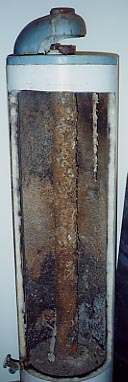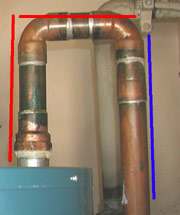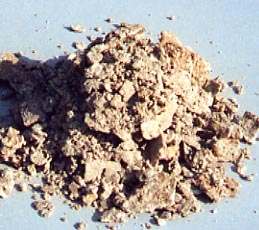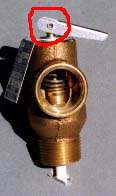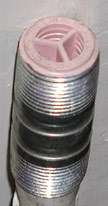All About Water Heaters
Just about everybody has a water heater or is served by one. But how much do you know about yours? We'd guess that people could tell more things about their cars than their water heaters, even though a car is vastly more complicated.
When a water heater breaks, most of us are in a hurry to get a replacement. Nobody likes cold showers.
Under those conditions, it's hard to buy wisely. So we thought we'd teach you a little about water heaters, tell you why we think the Richmond water heaters that Sutherlands sells are superior, and explain what your options are and how they might affect you.
|
|
| If not, there are factors you can use to compare one tank to another. Pay attention to gallonage, Btu input and first-hour recovery figures. Many people think, more gallons, more capacity, but Btu input is important, too. Some commercial water heaters have little capacity, loads of Btu. Ultimately though, figuring out need is as much art as science. Variables can range from whether you have low-flow showerheads to how long your teen-age daughter spends in the shower. |
| So if you want to cut standby losses, insulate the pipes, if you can, and when you install a tank heater, make heat traps out of copper flex lines. How? Use a longer flex than you need and make a big gooseneck in it, like a question mark. Heat will rise up the flex to the top of the gooseneck and no farther. The photo above left is of a commercial water heater, but the principle is the same. Heat will rise as far as the red lines, but not go into the blue because heat only rises. So insulating to a little beyond the top of the rise will be effective. |
Anodes, glass lining and longevityWhy do water heaters break? Does anybody know? We'll let you into the secret. While a glass lining mostly protects the tank from rusting, due to limitations in the manufacturing process there is always some exposed steel. Also, some glass linings are more complete than others. So exposed steel is protected from rusting by the use of sacrificial anode rods. The principle by which they work was discovered 200 years ago by Sir Humphrey Davies, an Englishman. When the tank is filled with water, a slow electrolytic reaction takes place whereby the anode corrodes and the steel is protected. When no anode remains, the steel rusts and the tank fails. If you soften your water, beware. That can increase the conductivity of the water and speed up the anode consumption. How fast a given tank lasts is a function of use, water temperature, the quality of its glass lining and water quality -- and how many anodes it has. Sutherlands sells water heaters in warranties of six, nine and 12 years. Longer-warranty water heaters generally have an additional anode rod in the hot port. It's also possible to buy a second anode made to screw into the port from www.waterheaterrescue.com and add it to a six-year-warranty tank. That will undoubtedly lengthen the life of the tank, but the warranty will still be six years. Whichever way you prefer to do it, having a tank with two anodes is another bargain like insulation, where spending a little extra money now will pay off in the long run. A 12-year-warranty water heater doesn't cost twice as much as a six-year-warranty one, and if a plumber is doing the installation, it's a small addition to the overall cost. If your water heater is inside your home, a two-anode tank decreases the risk of a flood, as well as the likelihood of not having hot water at an awkward moment, like on Christmas morning. Even people whose tanks are in the garage or basement can have water damage to things left on the floor. Another thing: some water heaters come with aluminum anodes. There are health issues connected with aluminum. Richmond heaters always come with magnesium anodes. |
Cutting the wait for hot waterIf your water heater is at one end of your house and your shower at the other, frustration will be the result. That's because the water lying in the piping in between will cool off and it will take you what seems like forever to run the shower long enough to get new hot water through the pipes from the tank. One solution to this is a recirculation system, either gravity-feed, or operated by a pump. Such a system keeps water circulating through the piping and returning to the tank so that when you turn the tap, there's no wait. Such a system cuts your water bill because you don't have to run so much down the drain to get the hot water flowing. But it will probably increase your energy bill, even if you insulate the pipes, because the heater will run more to keep the water hot. It can also be messy to retrofit a house with a recirculation system. An alternative is a Metlund device. At the touch of a button a minute before you need hot water, it pumps cold water from the hot line back into the cold line and back to the water heater, thus drawing hot water from the heater without running the cold water down the drain. It's simpler to install than a recirculation system and heat loss is limited to the water that cools off in the pipes after each use. The Chilipepper appliance works in a similar way. |
Smelly waterIn some parts of the United States, there are anaerobic bacteria in the water -- often in wells -- that will react with normal anode rods to create hydrogen sulfide gas. You open the hot tap, you get rotten egg odors. Sometimes it also discolors laundry. The quick fix for a typical 40-gallon tank is to open it and pour a couple of pints of hydrogen peroxide into the water. Chlorine bleach will also work, but peroxide is a lot safer. Then open the taps to get the treated water into the piping and kill the bacteria there. The long-term fix involves removing the anode(s) that came with the tank and replacing it with a special aluminum/zinc anode. Those are available at www.waterheaterrescue.com, which also contains considerable information about all aspects of water heaters and offers troubleshooting/problem-solving. |
Water heaters in apartmentsIf you are a landlord and are reading this, consider paying a visit to the commercial section of www.waterheaterrescue.com. The Tank, a water heater forumIn September, Water Heater Rescue started a bulletin board and forum called The Tank, where people can go to get answers to problems and discuss issues. Its purpose is to promote exchange of knowledge and understanding among plumbers, builders, architects, apartment people and the public. So if you have a problem that you don't see here, considering looking at the site's troubleshooting sections or using The Tank. |
Water heating from 100 years agoThey don't make 'em like they used to, which is too bad. There were many innovations from that period that are no longer in use today. Some designs were even superior, but because they cost more, they were relegated to the scrap heap of history. And undoubtedly, water heaters were vastly more ornate and beautiful, such as this Ewart Royal Geyser bath heater, than today's plain-looking steel cylinders. For a peek at water heating from a time when the idea of daily bathing was just becoming popular, visit the Weingarten Collection. | 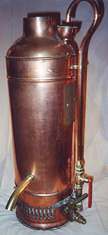 |
| | |
| Randy Schuyler operates www.waterheaterrescue.com, which is dedicated to making sure water heaters function safely, efficiently and for as long as possible. He has known the Sutherland Family for many years. |

